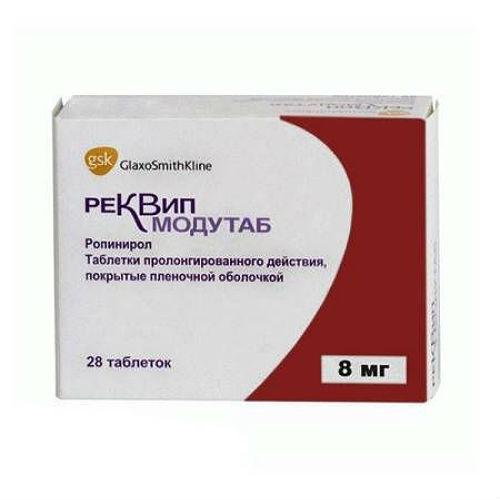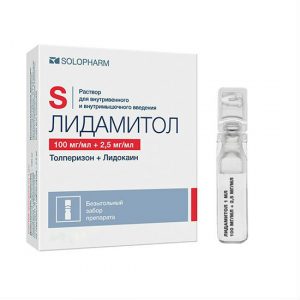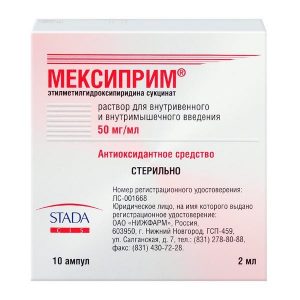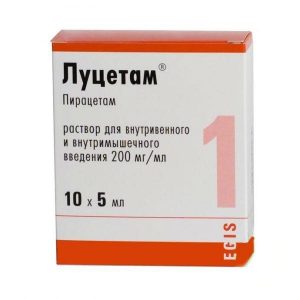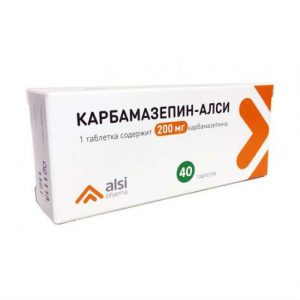Description
Release form
sustained-release tablets.
Packing
Per pack 28 pcs.
Pharmacological action
Requip Modub is an antiparkinsonian drug, a highly selective non-ergoline agonist of dopamine D 2 -, D 3 receptors, which has peripheral and central effects.
The drug does not act on collapsing presynaptic dopaminergic neurons of the black substance and acts directly as a synthetic neurotransmitter. Thus, ropinirole reduces the degree of physical inactivity, rigidity, and tremor, which are symptoms of parkinsonism.
Ropinirol compensates for dopamine deficiency in the substantia nigra and striatum by stimulating dopamine receptors in the striatum. Ropinirol enhances the effects of levodopa, including controlling the frequency of the on / off phenomenon and the effect of the end of the dose associated with prolonged therapy with levodopa drugs, and allows you to reduce the daily dose of levodopa. Ropinirol has an effect at the level of the hypothalamus and pituitary gland, inhibiting the secretion of prolactin.
Pharmacokinetics
The pharmacokinetics of ropinirole is similar in healthy people patients with Parkinson’s disease and patients with restless legs syndrome and varies depending on the dosage form.
Suction.
The bioavailability of ropinirole after oral administration is low and is approximately 50% (36% -57%). After oral administration of ropinirole in sustained-release tablets, its plasma concentration rises slowly, the average time to reach the maximum concentration (Tmax) is 6 hours. In an equilibrium state in patients with Parkinson’s disease, after oral administration of 12 mg of ropinirole once a day in combination with food, rich in fats, there was an increase in the systemic exposure of ropinirole, while there was an increase in the area under the concentration-time curve (AUC) and maximum concentration (Cmax) by 20% and 44%, respectively, Tmax was extended by and 3 hours However, in clinical trials of efficacy and safety, ropinirole was taken regardless of food intake.
Plasma Protein Binding and Distribution. Plasma protein binding is low (10 40%). Due to its high lipophilicity, ropinirole is characterized by a large distribution volume (approximately 7 l / kg).
Metabolism. Ropinirole is mainly metabolized by the isoenzyme CYP1A2.
The metabolite of ropinirole is mainly excreted by the kidneys.
Withdrawal. On average, the half-life of ropinirole from the systemic circulation is about 6 hours. An increase in the duration of the systemic effect of ropinirole (Cmax and AUC) is approximately proportional to the dose increase. There are no differences in the elimination of ropinirole after a single oral dose or with regular use.
Special patient groups
Elderly patients
Ropinirole clearance after oral administration is reduced by approximately 15% in elderly patients aged 65 years and older compared to younger patients. Dose adjustment in this category of patients is not required.
Patients with impaired renal function
Pharmacokinetic parameters do not change in patients with impaired renal function of mild to moderate degree and Parkinson’s disease.
In patients with end-stage renal failure who are undergoing permanent hemodialysis, ropinirole clearance by ingestion is reduced by about 30%.
Indications
Parkinson’s disease:
– Monotherapy of the early stages of the disease in patients requiring dopaminergic therapy to delay the administration of levodopa drugs.
– As part of combination therapy in patients receiving levodopa drugs, in order to increase the effectiveness of levodopa, including controlling the fluctuation (on-off) and the effect of the end of the dose in the presence of chronic levodopa therapy, as well as in order to reduce the daily dose of levodopa.
Contraindications
Acute psychosis.
– Impaired liver function.
– Severe renal impairment (CC less than 30 ml / min) that does not undergo regular hemodialysis.
– Rare hereditary diseases: – Lactose intolerance.
– Lactase deficiency.
– Absorption disorders of glucose or galactose.
Caution:
The drug should be used in patients with severe cardiovascular failure.
– Ropinirole can be given to patients with a history of psychotic disorders only if the expected benefits of its use outweigh the potential risk.
Pregnancy and lactation
Pregnancy and lactation (breastfeeding) are contraindicated.
Special instructions
Patients should be warned of the possible development of drowsiness or episodes of sudden falling asleep, sometimes not preceded by drowsiness. In the event of such reactions, consideration should be given to discontinuing therapy. Blood pressure monitoring is recommended because of the possibility of developing orthostatic hypotension.
In patients taking dopaminergic drugs, incl. ropinirole, reported disorders of attraction, including compulsive behavior, such as a pathological attraction to gambling and hypersexuality.
According to the literature, similar side effects of therapy have been observed in patients with Parkinson’s disease, receiving high doses of dopaminergic drugs, other risk factors may be a history of compulsive behavior or the combined use of several dopaminergic drugs. In this case, consider reducing the dose or discontinuing therapy.
A paradoxical deterioration in restless legs syndrome was observed with ropinirole therapy (earlier onset, increased intensity of manifestations, or progression of symptoms involving previously unaffected extremities), or rebound syndrome in the early morning hours (relapse of symptoms in the early morning hours).
When these symptoms appear, it is necessary to revise the treatment with ropinirole, to clarify the dose until the drug is possibly discontinued.
Composition of
1 tablet contains:
of ropinirole 8 mg.
Dosage and administration
The drug is administered orally 1 time / day at the same time, regardless of food intake. Tablets are taken whole without chewing, without breaking. An individual dose selection is recommended in accordance with the effectiveness and tolerability of the drug. A dose reduction is recommended if the patient is drowsy at any stage of dose selection. With the development of other adverse reactions, it is necessary to reduce the dose of the drug, followed by a gradual increase in dose. Keep in mind the need for dose titration when skipping a dose (one or more).
Monotherapy: – Initial dose. The recommended initial dose of the drug Rekvip Modutab is 2 mg 1 time / day for one week. Subsequently, the dose is increased by 2 mg at intervals of at least 1 week to 8 mg / day. Tab. The daily dose in accordance with the weeks (mg) 2, 4, 6, 8 mg.
Maintenance dose If, after selecting a dose, the therapeutic effect is not sufficiently pronounced or unstable, you can continue to increase the daily dose of the drug by 4 mg at intervals of 1-2 weeks (until the desired therapeutic effect is achieved). The dose can be changed depending on the therapeutic effect and increased to a maximum dose of 24 mg 1 time / day.
Combination therapy When using the drug RequiP Modub in doses, used in monotherapy, in combination with levodopa preparations, the dose of levodopa can be gradually reduced (depending on the clinical effect). In clinical studies in patients simultaneously receiving Recipip Modutab in sustained release tablets, the dose of levodopa was gradually reduced by approximately 30%. In patients with a progressive form of the disease, taking Rekvip Modutab in combination with levodopa preparations, dyskinesia may occur during the titration of a dose of ropinirole. Reducing the dose of levodopa drugs can lead to a decrease in this symptomatology.
Cancellation of therapy Recvip Modutab (like other dopaminergic drugs) should be discontinued, gradually reducing the daily dose for at least 1 week. If treatment was interrupted for 1 day or more, then, when resuming therapy, consideration should be given to the need for dose titration.
Use in special clinical cases Despite the possible decrease in clearance of the drug in patients aged 65 years and older, titration of the dose of ropinirole in this category of patients is carried out as usual.
In patients with impaired renal function of mild to moderate severity (CC 30-50 ml / min), the clearance of ropinirole does not change, dose adjustment of ropinirole is not required. For patients with end-stage renal failure undergoing hemodialysis, the recommended initial dose of ropinirole is 2 mg 1 time / day.
Subsequent dose increases should be based on an assessment of tolerance and effectiveness. The maximum daily dose in patients undergoing permanent hemodialysis is 18 mg. Administration of maintenance doses after hemodialysis is not required.
Side effects of
From the central nervous system: drowsiness, dyskinesia of hallucinations, dizziness (up to severe) confusion, drowsiness, dizziness (up to severe)
from the cardiovascular system: orthostatic hypotension, decreased blood pressure, orthostatic hypotension
From the digestive system: nausea, abdominal pain, dyspepsia, vomiting, constipation
General reactions: peripheral edema (including swelling of the legs)
From the central nervous system and peripheral nervous system: psychotic conditions (including delirium and delirium), perceptual disorders (including illusions, excluding hallucinations), increased impulsiveness, increased libido, including hypersexuality, pathological craving for gambling, marked drowsiness, episodes of sudden falling asleep (as in the case of the use of other dopaminergic drugs, these symptoms were very rarely recorded in patients with Parkinson’s disease). With a dose reduction or drug withdrawal, all symptoms disappeared. In most cases, concomitant sedatives were used.
From the cardiovascular system: orthostatic hypotension, decreased blood pressure.
Allergic reactions: urticaria, angioedema, rash, itching.
Drug Interactions
Typical antipsychotics and other centrally acting dopamine antagonists, such as sulpiride or metoclopramide, can reduce the effectiveness of ropinirole (simultaneous administration should be avoided). There was no pharmacokinetic interaction between ropinirole and levodopa or domperidone, which would require dose adjustment of these drugs.
Ropinirol does not interact with other drugs that are often used to treat Parkinson’s disease. In patients with Parkinson’s disease who were taking digoxin at the same time, there was no interaction of digoxin with ropinirole, which would require a dose adjustment. Ropinirole is mainly metabolized by the CYP1A2 isoenzyme.
Pharmacokinetic studies in patients with Parkinson’s disease have shown that ciprofloxacin increases C max and AUC of ropinirole by approximately 60% and 84%, respectively. In this regard, in patients receiving ropinirole, its dose should be adjusted when prescribing and discontinuing drugs that inhibit the CYP1A2 isoenzyme, for example, ciprofloxacin, enoxacin or fluvoxamine.
A pharmacokinetic study of drug interactions in patients with Parkinson’s disease between ropinirole and theophylline, a substrate of the CYP1A2 isoenzyme, showed that the pharmacokinetics of the drugs did not change. With the simultaneous use of ropinirole with other substrates of the isoenzyme CYP1A2, the pharmacokinetics of ropinirole does not change. An increase in the concentration of ropinirole in plasma was observed in patients who received estrogen in high doses.
In patients receiving hormone replacement therapy before starting treatment with ropinirole, treatment with ropinirole can be started as usual. However, if hormone replacement therapy is stopped or started during ropinirole therapy, a dose adjustment may be required.
There is no information on the possibility of interaction between ropinirole and ethanol. As with other centrally acting drugs, patients should be warned about the need to refrain from drinking alcohol during treatment with ropinirole. Nicotine is known to induce the CYP1A2 isoenzyme, therefore, if the patient starts or stops smoking during treatment with ropinirole, dose adjustment may be required.
Overdose
Symptoms: mainly due to dopaminergic action – nausea, vomiting, dizziness, drowsiness.
Treatment: The use of dopamine antagonists such as typical neuroleptics and metoclopramide.
Storage conditions
Store in the original package, at a temperature not exceeding 25 ° C.
Shelf life
3 years.
Active ingredient
ropinerol
dosage form
tablets
Possible product names
REQUIPE MODUTAB 0.008 N28 TABLE PROLONG S / L
Recvip Modutab 8mg Tab. prolong. deyst. cover captivity. about. X28
REQUIPE MODUTAB TAB. PROLONG. Deyst. P / O CAPTURE. 8MG No. 28
REQUIPE MODUTAB TAB.PROLONG. 8MG No. 28
RequiP Modub Table. prolong. action p.p. 8mg N28 Spain
GlaxoSmithKline, UK
